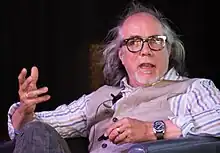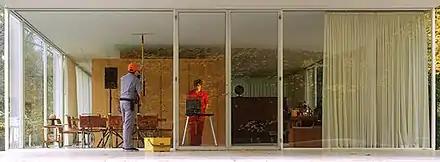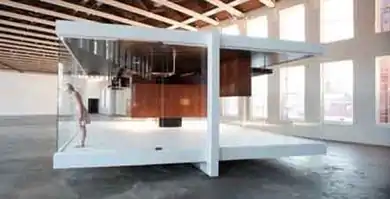Iñigo Manglano-Ovalle
Iñigo Manglano-Ovalle (born 1961, Madrid, Spain) is an American conceptual artist known for multidisciplinary, socially oriented sculpture, video and installations and urban community-based projects of the 1990s.[1][2][3] His work often explores a dialectical relationships involving minimalist aesthetics, the utopian ambitions of modernism and science, and the resulting—often negative—social, geopolitical and ecological consequences of such ideologies.[4][5][6] New York Times critic Holland Cotter wrote that Manglano-Ovalle was adept in "distilling complex ideas into inviting visual metaphors," while Jody Zellen described his work as "infused with a formal elegance and sociopolitical content."[7][8] Manglano-Ovalle has been featured in solo exhibitions at the Art Institute of Chicago,[9] MASS MoCA,[10] Museo Tamayo Arte Contemporaneo[11] and Museum of Contemporary Art, Chicago (MCA),[12] and participated in Documenta 12,[13] the Venice Biennale, Whitney Biennial,[14] and Bienal de São Paulo.[1][15][16] He has been recognized with MacArthur Foundation,[17] Guggenheim,[1] and National Endowment for the Arts fellowships and his work belongs to the collections of forty major institutions.[18] He has been a professor at Northwestern University since 2012 and lives and works in Chicago.[16]
Iñigo Manglano-Ovalle | |
|---|---|
 | |
| Born | 1961 Madrid, Spain |
| Nationality | American |
| Education | School of the Art Institute of Chicago, Williams College |
| Known for | Conceptual art, Installation art, Sculpture, Video, Photography |
| Awards | MacArthur Foundation, John Simon Guggenheim Memorial Foundation, National Endowment for the Arts |
| Website | Iñigo Manglano-Ovalle |

Life and career
Manglano-Ovalle was born in Madrid and raised in Bogotá, Colombia and Chicago, Illinois.[3][19] He received BA degrees in art and art history and Latin American and Spanish literature from Williams College (1983), before earning an MFA in Sculpture from the School of the Art Institute of Chicago (SAIC) in 1989.[1] He exhibited actively during graduate school, at alternatives spaces such as Randolph Street Gallery and Hyde Park Art Center, and quickly became part of a burgeoning conceptual scene in Chicago that sought to address political issues in non-didactic ways.[20][3][19] Since that time, he has had major solo exhibitions at the Art Institute of Chicago (2010, 2005, 1999),[21] MASS MoCA (2009),[22] Rochester Art Center (2006),[23] Krefelder Kunstmuseen (2005),[24] Museo de Arte Contemporáneo de Monterrey (2004), Museo Tamayo Arte Contemporaneo (2003),[11] MCA, Chicago (1997, 1993), Christopher Grimes Gallery (1998–2017, Santa Monica),[8] Max Protetch Gallery (1998–2010, New York),[25] and Galerie Thomas Schulte (2006–17),[26] among others.[1][18] He has also appeared in group exhibitions at the Museum of Modern Art, Solomon R. Guggenheim Museum, and Guggenheim Museum Bilbao.[1][16]
Work

Manglano-Ovalle’s diverse work is connected by its interest in probing the underlying forces, systems and histories that shape and describe contemporary identity, ethics, aesthetics, climate, and politics.[27] His early projects employed multi-faceted, community-oriented strategies to explore cultural identity, migration and immigration, social and geographic boundaries, and urban violence.[28] His later work evolved in a more conceptual direction, initiating wider sociopolitical dialogues on culture, science and technology, ecosystems, and geopolitics.[29][8]
Community-oriented and socially-focused projects (1990s)
Manglano-Ovalle's early work was rooted in localized communities and the personal experience of living between cultures.[30][31][28] For Assigned Identity Project (1990), he worked with a West Town, Chicago community center, fusing art (scaled-up green cards, fingerprints and topographical maps examining identity and categorization) with community service teaching a practical course on amnesty and federal (INS) practices.[28][32][19] His Tele-Vecindario (1993) was part of the pioneering, Mary Jane Jacob-curated "Culture in Action" social practice event, and gained him widespread attention.[33][30][34][35] He collaborated with a group of neighboring at-risk Latino teens, leading to the formation of Street-Level Video, a training collective that empowered youths to articulate street culture and community concerns about gang activity, gentrification, social control and cultural fragmentation.[36][37][34][30] The project developed into a sprawling dialogue on residential social space, presented at public screenings, a 71-monitor, 46-video block party (involving the collaboration of four rival gangs), and video installations created in conjunction with the MCA Chicago.[30][36][38][39]
Manglano-Ovalle explored similar issues in early sculpture and installations incorporating unorthodox elements, such as suspended inner tubes evoking the iconic bolsa (raft) (Flotilla, 1991), actual rafts (Balsero, 1994),[12] car sound systems (Subwoofer, 1995), or a 1964 Chevy Impala (Flora and Fauna, 1997) referencing low-rider car culture.[29][32][23] Critics described his minimalist installation, Bloom (1995–6), as a subversively seductive yet repulsive meditation on violence; it consisted of Plexiglas cases on spare metal tables containing luminous blocks of ballistic gelatin replicating human flesh, into which hollow-point bullets were fired.[27][32] The transitional Note on Levitating the U.S. Pentagon or How to Operate a Car Jack (1996) foreshadowed his growing conceptual and political focus; it featured 195 hydraulic jacks arranged in a pentagonal formation, referencing low-rider culture, the minimalism of Robert Morris, and 1960s Happenings and protests.[32]

Conceptual work: sculpture, video and installations (1997— )
Manglano-Ovalle's later projects often use natural or modernist cultural forms as metaphors to consider social systems involving identity, science and technology, politics and war.[40][41][23][42] He transforms research and data from many disciplines (engineering, architecture, genomics, climatology, astrophysics) into technologically sophisticated, often minimalist sculptures, videos and installations.[15][43] The Garden of Delights (1998) re-visualized genetic coding in order to examine its potential use in the representation, portrayal and categorization of identity.[6][27][41] It featured forty-eight life-size depictions of human DNA samples, presented in triptychs resembling vibrant, color-field abstraction whose visual similarity evinced common lineage despite representing individuality.[6][27][41][44] Heavenly Bodies (2003) translated genetic coding into cloud motifs, whose celestial immateriality undermined notions of certainty associated with DNA testing.[41]

In several projects, Manglano-Ovalle investigated intersections of cultural systems, such as modernism, with politics, science, and nature. The video-installation trilogy Le Baiser/The Kiss (1999), Climate (2000) and In Ordinary Time (2001)—all set in Mies van der Rohe buildings—and Always After (The Glass House) (2006) engage the beauty, ambitions and failings of modernism as well as interrelated environmental, geopolitical, class and social issues;[45][7][27][14] New York Times critic Ken Johnson called them "sleek and suspenseful video installations that meditate on modern technocracy."[25] Manglano-Ovalle revisited these themes in a Whitney Museum show he designed ("Mies in America," 2001) and Gravity Is a Force To Be Reckoned With (MASS MoCA, 2009), in which he reconstructed van der Rohe’s never-built House with Four Columns (1951)—a square, open- walled glass structure—at half scale (25 x 25 feet) and inverted, with its furniture and partition walls installed upside down from the ceiling (the original's home's floor).[46][47][22]
In The Krefeld Suite (2005) Manglano-Ovalle focused on the tectonic, plateau-like structure of icebergs, staging interventions in two van der Rohe villas to connect modernist architectural forms and natural forms and forces.[24][48] Iceberg (r11i01) (2005), a 25-foot sculpture consisting of a matrix of more than 1,600 aluminum tubes, captured the structure of a once-existing, 460-foot Labrador Sea iceberg from advanced radar and sonar data; juxtaposing the utopian vision of Fuller's geodesic dome (in crumpled form) with the threat of global warming, the sculpture intimated modernism's failure, particularly in another version shown on its side, Recumbent Iceberg (r11i01) (2006).[49][4][27]

Three large-scale works employing technical processes of data gathering, modeling and fabrication connect science and political power. Cloud Prototype No. 1 (2003) used atmospheric data to create a gargantuan, amorphous titanium-alloy and fiberglass sculpture capturing the fleeting form of a thundercloud;[49][50][25] its frozen quality and resemblance to a nuclear blast cloud evoke liminal, transformative moments between benign and perilous, progress and destruction.[27][4][41] Phantom Truck (Documenta 12, 2007) was a physical realization of the biological weapons lab described (but never validated) in Colin Powell's 2003 United Nations speech leading up to the U.S. invasion of Iraq.[13][51] Manglano-Ovalle built the vaguely industrial, container-like structure using computer renderings based on satellite images, State Department renderings and descriptions in Powell's speech.[2][50][13] Displayed in a darkened gallery, the barely visible form was described by curator Elizabeth Armstrong as evoking the shadowy political camouflage that inspired it—"a chilling encounter with a fabrication of a falsehood."[2] Prototype for Re-Entry (2015) is an enlarged (36-foot) version of Brancusi's iconic Bird in Space sculpture suspended in flight that was commissioned for a U.S. Food and Drug Administration building that was once the site of a post-World War II weapons laboratory.[52][40] It uses the site's historical role and the aesthetics of Brancusi's work as points of departure to investigate the parallel searches of modern art and science/weapons development for perfection;[52][40] the project included a (successful) aerodynamics test of a reproduction of the sculpture in the site's still-active hypervelocity wind tunnel.[40][52]
In later multi-component works, Manglano-Ovalle returned to ecological themes, resource extraction and coal and deforestation.[18][53][54] His permanent 2013 public work, Weather Field No. 1, is a kinetic array of weather vanes and anemometers for Tongva Park in Santa Monica, California.[55] The installation Well (2014–5) comprises an exhibition and permanent work of land art in Santa Clara Pueblo, New Mexico in which Manglano-Ovalle installed stainless steel hand pumps to manually extract water from aquifers below for public consumption.[53] It explores the issue of water extraction while reframing minimalist and readymade art conventions by maintaining its object's utilitarian function.[18][53]
Recognition and collections
Manglano-Ovalle has received fellowships from the John Simon Guggenheim Memorial Foundation (2009),[1] MacArthur Foundation (2001),[17] United States Artists (2011),[56] and National Endowment for the Arts (1995), as well as a Wexner Center for the Arts Media Arts Award (1997–2001) and Artadia Award (2008),[43] among others.[16] His work belongs to the public collections of forty institutions, including the Solomon R. Guggenheim Museum,[57] Art Institute of Chicago,[58] Whitney Museum,[59] Berkeley Art Museum and Pacific Film Archive,[60] Library of Congress, Museo de Arte Contemporane (Bilbao), Museo Nacional Centro de Arte Reina Sofia, Museum of Contemporary Art, Chicago,[61] Museum of Contemporary Art San Diego,[62] Museum für Moderne Kunst, National Gallery of Victoria,[63] and Stedelijk Museum voor Actuele Kunst (SMAK).[18]
References
- Solomon R. Guggenheim Museum. "Iñigo Manglano-Ovalle," Collection. Retrieved June 27, 2019.
- Armstrong, Elizabeth. "On the Border of the Real," in More Real: Art in the Age of Truthiness, by Elizabeth Armstrong, London/New York: Prestel Publishing, Minneapolis Institute of Arts, Site Santa Fe, 2012. Retrieved July 12, 2018.
- Molon, Dominic. "Iñigo Manglano-Ovalle" in Art in Chicago 1945-1995, Museum of Contemporary Art, ed. Lynne Warren, New York: Thames and Hudson, 1996, p. 267. Retrieved July 12, 2018.
- Briggs, Patricia. "Iñigo Manglano-Ovalle, Rochester Art Center," Artforum, November 2006. Retrieved July 12, 2018.
- Shulman, Ken. "A Love-Hate Affair With Architecture," The New York Times, March 31, 2002, Sect. 2, p. 33. Retrieved July 12, 2018.
- Platt, Ron. "Iñigo Manglano–Ovalle: The Garden of Delights," Iñigo Manglano–Ovalle: The Garden of Delights, Winston–Salem, NC: Southeastern Center for Contemporary Art, 1998.
- Cotter, Holland. "Iñigo Manglano-Ovalle," The New York Times, April 21, 2000. Retrieved July 12, 2018.
- Zellen, Jody. "Iñigo Manglano-Ovalle, Christopher Grimes Gallery," Artillery Magazine, 2012.
- Snodgrass, Susan. "Iñigo Manglano-Ovalle at the Art Institute of Chicago," Art in America, November 2005, p. 187.
- MASS MoCA. Gravity is a Force to be Reckoned With, Catalogue, North Adams, MA: MASS MoCA, 2010.
- Museo Tamayo Arte Contemporáneo (Mexico City) and Museo de Arte Contemporáneo de Monterrey. Iñigo Manglano-Ovalle, Monterrey Mexico: Museo Tamayo Arte Contemporáneo, Museo de Arte Contemporáneo de Monterrey, 2004.
- Camper, Fred. "Anti-Masterpieces: Alfons Koller, Iñigo Manglano–Ovalle and Kara Walker," Chicago Reader, February 7, 1997. Retrieved July 12, 2018.
- Shindler, Kelly. "Iñigo Manglano-Ovalle’s Phantom Truck at Documenta 12," Art21, July 12, 2007. Retrieved July 12, 2018.
- Kimmelman, Michael. "A New Whitney Team Makes Its Biennial Pitch," The New York Times, March 24, 2000, p. 31E. Retrieved July 12, 2018.
- Art21. "Iñigo Manglano-Ovalle," Artists. Retrieved June 27, 2019.
- Northwestern University. "Iñigo Manglano-Ovalle," Art, Theory, Practice Faculty. Retrieved June 27, 2019.
- MacArthur Foundation. "Iñigo Manglano-Ovalle," MacArthur Fellows Program. Retrieved July 12, 2018.
- Sanroman, Lucia, and J. Gibran Villalobos. Well: Iñigo Manglano–Ovalle. Santa Monica, CA: Christopher Grimes Gallery, 2015.
- Taft, Maggie. "Chicago Speaks, 1990–Present: Mary Jane Jacob and Iñigo Manglano-Ovalle," In Art in Chicago: A History from the Fire to Now, Ed. Taft, Maggie and Robert Cozzolino, Chicago: The University of Chicago Press, 2018, p. 335–340. Retrieved July 12, 2018.
- Artner, Alan G. "Sharp conceptual show dares to be different," Chicago Tribune, January 22, 1993, p. 56. Retrieved July 12, 2018.
- Warren, Lynne. "Curating Chicago," In Art in Chicago: A History from the Fire to Now, Ed. Taft, Maggie and Robert Cozzolino, Chicago: The University of Chicago Press, 2018, p. 239. Retrieved July 12, 2018.
- Smee, Sebastian. "For Art Lovers, Western Mass. Awaits," The Boston Globe, March 7, 2010, p. N6. Retrieved July 12, 2018.
- Rochester Art Center. Iñigo Manglano-Ovalle: Blinking Out of Existence, Rochester, MN: Rochester Art Center, 2007. Retrieved June 27, 2019.
- Hentschel, Martin (ed). "Iñigo Manglano-Ovalle: The Krefeld Suite, An Introduction," The Krefeld Suite, Krefeld, Germany: Haus Esters and Haus Lange of the Krefelder Kunstmuseen, 2005.
- Johnson, Ken. "Iñigo Manglano-Ovalle—'Purgatory'," The New York Times, February 14, 2003. Retrieved July 12, 2018.
- Galerie Thomas Schulte. "Iñigo Manglano-Ovalle," Artists. Retrieved July 12, 2018.
- Douglas, Kris. "Searching for Everybody and All at the Same Time," Iñigo Manglano-Ovalle: Blinking Out of Existence, Rochester, MN: Rochester Art Center, 2007. Retrieved June 27, 2019.
- Kirshner, Judith Russi. "Resisting Regionalism," " in Art in Chicago 1945-1995, Museum of Contemporary Art, ed. Lynne Warren, New York: Thames and Hudson, 1996, p. 267. Retrieved July 12, 2018.
- Sherlock, Maureen. "Shadow Dancing: the Work of Iñigo Manglano–Ovalle," Iñigo Manglano–Ovalle: The Garden of Delights, Winston–Salem, NC: Southeastern Center for Contemporary Art, 1998.
- Jacob, Mary Jane and Michael Brenson, Eve M. Olsen. "Tele-Vecindario," in Culture in Action, Seattle, WA: Bay Press, Inc., 1995. Retrieved July 12, 2018.
- Artner, Alan G. "12 artists go to heart of Hispanic culture," Chicago Tribune, May 24, 1991: p. 68. Retrieved July 12, 2018.
- Clearwater, Bonnie. "Studio Visit," Trans > arts.cultures.media, Vol. 1/2, Issue 3/4, 1997.
- Tormollan, Carole. "Culture in Action: New Public Art in Chicago," High Performance, Spring 1994, p. 50–54.
- Brenson Michael. "Healing in Time," in Culture in Action (essays by Mary Jane Jacob, Michael Brenson, Eve M. Olsen), Seattle, WA: Bay Press, Inc., 1995. Retrieved July 12, 2018.
- Sorkin, Jenni. "Alterity Rocks, 1973–1993," In Art in Chicago: A History from the Fire to Now, Ed. Taft, Maggie and Robert Cozzolino, Chicago: The University of Chicago Press, 2018, p. 278. Retrieved July 12, 2018.
- Kirshner, Judith Russi. " Street-Level Video Block Party," Artforum, December 1993. Retrieved July 12, 2018.
- Snodgrass, Susan. "Culture in Action," Art Papers, November/December 1993, p. 7–11.
- Kimmelman, Michael. "Of Candy Bars and Public Art," The New York Times, September 26, 1993, Retrieved July 12, 2018.
- Muschamp, Herbert. "Design vs. Environment: Architects Debate," The New York Times June 23, 1993, p. 1B. Retrieved July 12, 2018.
- Mertens, Catherine (ed). Iñigo Manglano-Ovalle: Bird in Space at MACH10, Berlin: Argo Books/Schering Stiftung, 2013. Retrieved July 12, 2018.
- Barliant, Claire. "Hold Yourself in Mid Air," Iñigo Manglano-Ovalle: Blinking Out of Existence, Rochester, MN: Rochester Art Center, 2007. Retrieved June 27, 2019.
- Yood, James. "Iñigo Manglano-Ovalle, Donald Young Gallery " Artforum, February 2009. Retrieved July 12, 2018.
- Artadia. Iñigo Manglano-Ovalle," Artists. Retrieved July 12, 2018.
- Pollack, Barbara. "The Genetic Esthetic," ARTnews, April 2000, p. 134–6.
- Dailey, Meghan. "US Shorts," Artforum, September 2001. Retrieved July 12, 2018.
- Wilson, Michael. "'Mies in America,' Whitney Museum of American Art" Artforum, July 11, 2001. Retrieved July 12, 2018.
- Diehl, Travis. "Iñigo Manglano-Ovalle, The Power Plant" Artforum, May 3, 2011. Retrieved July 12, 2018.
- Krimko Stuart. ["Iñigo Manglano-Ovalle and the Language of Invention," The Krefeld Suite, Krefeld, Germany: Haus Esters and Haus Lange of the Krefelder Kunstmuseen, 2005.
- Danto, Ginger. "Ice Bound," The New York Times, March 27, 2005, p. AR 6. Retrieved July 12, 2018.
- Hoffman, Irene. "Iñigo Manglano-Ovalle," in More Real: Art in the Age of Truthiness, by Elizabeth Armstrong, London/New York: Prestel Publishing, Minneapolis Institute of Arts, Site Santa Fe, 2012. Retrieved July 12, 2018.
- Birnbaum, Daniel. "Documenta 12," Artforum, September 2007. Retrieved July 12, 2018.
- Kaufman, Marc. "How Nazi scientists and their wind tunnels ended up in D.C.’s suburbs," The Washington Post, November 12, 2015. Retrieved July 12, 2018.
- Gluck, Marissa. "Iñigo Manglano-Ovalle Brings 500 Gallons of Water to Los Angeles," KCET, September 10, 2015. Retrieved June 27, 2019.
- Manglano-Ovalle, Iñigo, and Olmo Garcia. Iñigo Manglano-Ovalle - The Black Forest, Museo Universidad De Navarra, 2015.
- Kudler, Adrian Glick. "Major New Santa Monica Park Getting Weather Controlling Art". Curbed. Retrieved 11 October 2023.
- Artforum. "Seven Visual Artists Named USA Fellows," Artforum, December 05, 2011. Retrieved July 12, 2018.
- Vogel, Carol. "Inside Art," The New York Times, December 21, 2001. Retrieved July 12, 2018.
- Art Institute of Chicago. "Iñigo Manglano-Ovalle," Artists. Retrieved July 12, 2018.
- Whitney Museum of American Art. "Iñigo Manglano-Ovalle," Collection. Retrieved July 12, 2018.
- Berkeley Art Museum and Pacific Film Archive. Juggernaut, Collection. Retrieved July 12, 2018.
- Museum of Contemporary Art, Chicago. "Iñigo Manglano-Ovalle," Artists. Retrieved July 12, 2018.
- Museum of Contemporary Art San Diego. "Iñigo Manglano-Ovalle," Artists. Retrieved July 12, 2018.
- National Gallery of Victoria. "Iñigo Manglano-Ovalle," Collection. Retrieved July 12, 2018.
External links
- Iñigo Manglano-Ovalle official website
- "Interview with Inigo Manglano-Ovalle Part I", Portlandart, February 27, 2010
- "Interview with Inigo Manglano-Ovalle Part II", Portlandart, February 27, 2010